I. Fundamentals
Roman Numerals and SATB Chord Construction
Samuel Brady and Kris Shaffer
Key Takeaways
- Roman numeral analysis is an analytical procedure in which musicians use Roman numerals to identify chords within the context of key signatures.
- Roman numerals identify the scale degree of the chord’s root, the chord’s quality, and any extensions or inversions the chord may include.
- Uppercase Roman numerals denote major triads, and lowercase Roman numerals denote minor triads. A o symbol after a lowercase Roman numeral represents a diminished triad, while a + sign after an uppercase Roman numeral represents an augmented triad.
- The Roman numeral quality of a seventh chord is dependent on the chord’s triad; the exceptions are half-diminished and fully diminished seventh chords, whose qualities are dependent on their chordal seventh.
- When constructing a chord in SATB style, there are six rules to keep in mind: stem direction, chord construction, range, spacing, voice crossing, and doubling.
Writing Roman Numerals
Music theorists use Roman numerals to identify chords within the context of key signatures. Roman numerals identify the scale degree of the chord’s root, the chord’s quality, and any extensions or inversions the chord may include. Because Roman numerals convey the same information across major and minor key signatures, using them can save time in analyzing Western common practice music.
The three columns of Example 1 show the Arabic numerals 1 through 7 alongside the corresponding uppercase and lowercase Roman numerals.
[table id=68 /]
Example 1. Arabic and Roman numerals.
To type uppercase Roman numerals, use the uppercase Latin alphabet letters “I” and “V”; likewise, for lowercase Roman numerals, type the lowercase “i” and “v.” The Roman numerals IV (4) and VI (6) are often confused; to remember the difference, think of IV (4) as V minus I (5 minus 1), and VI (6) as V plus I (5 plus 1).
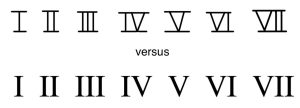
Handwritten uppercase Roman numerals have horizontal bars across the top and bottom of the numeral, in order to further distinguish between uppercase and lowercase (Example 2). There is no such difference with lowercase Roman numerals.
Roman Numerals and Triad Quality
Roman numerals indicate three things: the scale degree of a chord’s root, the quality of the chord, and the chord’s inversion (see Inversion below). The number represented by the Roman numeral (see Example 1) corresponds to the scale degree of the chord’s root in whatever key the music is in. Uppercase Roman numerals denote major triads, and lowercase Roman numerals denote minor triads. For example, in a major key, a chord built on the first scale degree, [latex]\hat1[/latex] or do, is identified as “I,” and a chord built on the second scale degree, [latex]\hat2[/latex] or re, is identified by the lowercase Roman numeral “ii.” Lowercase Roman numerals followed by a superscript “o” (such as viio) represent diminished triads. Uppercase Roman numerals followed by a + sign (for example, the rare V+) represent augmented triads.
In the analysis of Western music, Roman numerals are generally placed below the bottom staff. Some music theorists prefer to use only uppercase Roman numerals, a system which assumes chord quality is intuited; in this textbook, we privilege the distinction of triadic qualities as denoted by uppercase and lowercase Roman numerals.
Example 3 shows the triads and seventh chords of a G major scale, labeled with chord symbols and now Roman numerals (in blue). The solfège and scale degree of the roots are also labeled.
Example 3. Roman numerals of triads in major and minor keys.
The Roman numerals and qualities of triads in major keys are as follows:
- I: major
- ii: minor
- ⅲ: minor
- IV: major
- V: major
- vi: minor
- vii°: diminished
The Roman numerals and qualities of triads in minor keys are as follows:
-
- ⅰ: minor
- ii°: diminished
- III: major
- iv: minor
- v: minor
- V: major (raised leading tone)
- VI: major
- VII: major
- vii°: diminished (raised leading tone)
Note that the quality of v/V and VII/viio differs depending on whether or not the leading tone is raised.
Roman Numerals and Seventh Chord Quality
Roman numeral labels for seventh chords add a superscript 7: for example, V7, ii7, and viio7. The capitalization of the Roman numeral depends on the quality of its triad: uppercase for a major triad (e.g., V7), lowercase for a minor or diminished triad (e.g., ii7). Half-diminished and fully diminished seventh chords, which both contain a diminished triad, are distinguished by an additional symbol after the lowercase Roman numeral: ∅ for half-diminished (e.g., vii∅7) and o for fully diminished (e.g., viio7).
Example 4 shows the triads and seventh chords of a G minor scale labeled with chord symbols and now Roman numerals (in blue). The solfège and scale degree of the roots are also labeled.
Example 4. Roman numerals of seventh chords in major and minor keys.
The Roman numeral and qualities of seventh chords in major keys are as follows:
-
- I7: major-major seventh (major seventh)
- ii7: minor-minor seventh (minor seventh)
- ⅲ7: minor-minor seventh (minor seventh)
- IV7: major-major seventh (major seventh)
- V7: major-minor seventh (dominant seventh)
- vi7: minor-minor seventh (minor seventh)
- vii∅7: half-diminished seventh
The Roman numeral and qualities of seventh chords in minor keys are as follows:
-
- ⅰ7: minor-minor seventh (minor seventh)
- ii∅7: half-diminished seventh
- III7: major-major seventh (major seventh)
- iv7: minor-minor seventh (minor seventh)
- v7: minor-minor seventh (minor seventh)
- V7: major-minor seventh (dominant seventh)
- VI7: major-major seventh (major seventh)
- VII7: major-minor seventh (dominant seventh)
- vii°7: fully diminished seventh (diminished seventh)
Note that the quality of v7/V7 and VII7/viio7 differs depending on whether or not the leading tone is raised.
Additionally, major seventh and dominant seventh chords have the same Roman numeral nomenclature; in other words, a I7 chord and a V7 chord are written the same even though the former is a major seventh chord and the latter is a dominant seventh chord. The difference would be discerned from the musical context.
Inversion
Roman numerals also denote inversions, shown through figured bass symbols placed after the Roman numeral (see the Inversion and Figured Bass chapter). For example, a superscript 6 represents a first inversion triad, and the figures [latex]^4_3[/latex] would indicate a second inversion seventh chord. Example 5 shows four different inverted chords with Roman numerals:
Example 5. Four inverted chords with Roman numerals and figures.
Roman Numeral Analysis
To complete a Roman numeral analysis, begin by identifying the work’s key and writing it under the key signature at the beginning of the work, using an uppercase letter name for a major key and a lowercase letter name for a minor key. It can also be helpful to write a lowercase “m” following the letter name of a minor key (e.g., “dm” for D minor). Be sure to apply any applicable accidental (e.g., “E♭” for E-flat major).
After you identify and write the key at the start of the work, follow these steps for each chord to complete the Roman numeral analysis:
-
- If a chord is in inversion, stack it in root position (preferably mentally).
- Identify all the notes of the chord, taking its quality into account.
- Write the Roman numeral that corresponds with the scale degree of the chord’s root, reflecting the quality in the Roman numeral (uppercase or lowercase).
- Write any additional quality symbols ( o, ∅, +) as needed.
- Write figures after the Roman numeral.
Example 6 shows a Roman numeral analysis for Johann Sebastian Bach’s chorale “Jesu meiner Seelen Wonne” (1642), which translates to “Jesus, delight of my soul.” When analyzing this chorale, ignore the notes in parentheses. It is recommended that you cover up the Roman numerals in this example and try to generate them on your own before uncovering them:
Example 6. Roman numeral analysis of an excerpt of Johann Sebastian Bach’s “Jesu, meiner Seelen Wonne” (BWV 359).
Roman numeral analysis is not just limited to chorales; indeed, you can apply them to many different genres of music. Example 7 shows an excerpt from “Caro Mio Ben” (c. 1783), which translates to “Dearly beloved” and is attributed to Guiseppe Giodani, with a Roman numeral analysis:
Example 7. Roman numeral analysis of an excerpt of Giuseppe Giordani’s “Caro Mio Ben.”
When the same chord occurs two or more times in a row, which is common, you can choose whether to repeat the Roman numeral (as in measure 1 of Example 7) or not (as in measure 2 of Example 6).
Writing Chords in SATB Style
Music theorists sometimes simplify compositions into four parts (or voices) in order to make their harmonic content more readily accessible. This practice is called SATB style, abbreviated after the four common voice parts of a choir––soprano (S), alto (A), tenor (T), and bass (B). When constructing a chord in strict SATB style, there are six rules musicians generally follow:
These six parameters form the basis of counterpoint and part writing, explored further in the sections Counterpoint and Galant Schemas and Diatonic Harmony, Tonicization, and Modulation.
Stem Direction
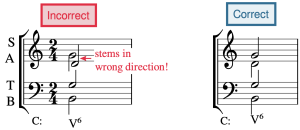
On a grand staff in SATB style, the soprano and alto are written in the treble clef (upper staff), while the tenor and bass are written in the bass clef (lower staff). The soprano and tenor voices receive up-stems, while the alto and bass parts receive down-stems. If the stem direction is crossed, this is an error. Example 8 shows a chord with incorrect stemming, followed by the corrected version.
Chord Construction
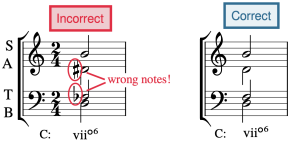
Be sure to check each chord for correct notes and accidentals, and make sure that your chords are not missing any notes. In Example 9, the first chord has accidentals erroneously added to two of the pitches, which are removed in the second chord to create a correct B diminished triad in first inversion.
The bass voice must always correspond with the inversion that the Roman numeral’s figures indicate. However, the order of the upper notes can be arranged in many ways. In other words, there is not necessarily just one correct way to voice a chord.
Range
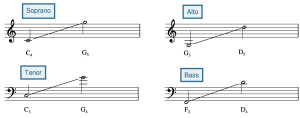
There is a generally accepted range for each voice (Example 10):
- Soprano – C4 to G5
- Alto – G3 to D5
- Tenor – C3 to G4
- Bass – F2 to D4
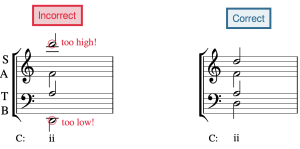
In Example 11, the soprano and bass notes are out of range; this is corrected by moving the soprano note down by an octave and the bass note up by an octave.
Spacing
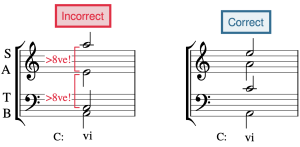
There should be no more than an octave between adjacent upper voices (soprano and alto, alto and tenor) and no more than a twelfth between the tenor and bass. The most common spacing error occurs between the alto and tenor because the notes appear in different clefs. Example 12 first shows a chord with incorrect spacing—the soprano and alto are more than an octave apart, as are the alto and tenor—followed by a corrected version:
Voice Crossing
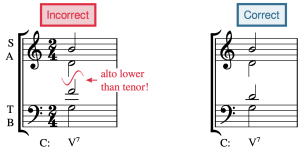
The ranges of voices should not cross. In other words, the soprano must always be higher than the alto, the alto must always be higher than the tenor, and the tenor must always be higher than the bass. In Example 13, the alto and tenor voices are crossed. This error is also the most common between the alto and tenor voices.
Doubling
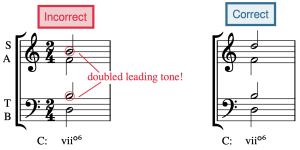
In a triad, the note in the bass is usually doubled in an upper voice. However, there is an exception to this: the leading tone is never doubled. Other tendency tones, such as chordal sevenths, are also never doubled. Seventh chords don’t have any notes doubled because they contain four notes, one for each voice part. Incorrect doubling is seen in the first measure of Example 14, where the leading tone is doubled, followed by a corrected voicing in the second measure.
- Roman Numeral Analysis: Triads (musictheory.net)
- Harmonizing Scales & Roman Numeral Analysis (Kaitlan Bove)
- Roman Numerals (learnmusictheory.net)
- Roman Numeral Analysis (Phillip Magnuson)
- Roman Numeral Analysis (8notes.com)
- Roman Numeral Chord Symbols (Robert Hutchinson)
- Roman Numerals in Major Flashcards (gmajormusictheory.org)
- Roman Numerals in Minor Flashcards (gmajormusictheory.org)
- Inversion & Roman Numerals in Major Flashcards (gmajormusictheory.org)
- Inversion & Roman Numerals in Minor Flashcards (gmajormusictheory.org)
- How the Roman Numeral System Works (YouTube)
- Roman Numeral Identification, pp. 15–16, 18 (.pdf), pp. 5–7 (.pdf), pp. 1, 3, 4 (.pdf), (.pdf, .pdf, .pdf, .pdf)
- Roman Numeral Identification and Construction, p. 14 (triads) and 17 (seventh chords) (.pdf), p. 11 (.pdf), p. 8 (.pdf), p. 5 (.pdf), (website, website)
- Roman Numeral Construction, p. 22 (.pdf)
Media Attributions
- Handwritten versus typed Roman numerals
Labeling chords with Roman numerals (and, often, figures).
A single step within a scale; usually indicated by either a solfège syllable or an Arabic numeral with a caret.
A term that summarizes the quality of the third, fifth, and seventh (if applicable) above the root of the chord. Common chord qualities are major, minor, diminished, half-diminished, dominant, and augmented.
Changing the bass note of a harmony so that, for example, the third is in the bass instead of the root.
A musical texture with soprano (S), alto (A), tenor (T), and bass (B) parts.
On a grand staff in SATB style, the soprano and tenor are up-stemmed, while the alto and bass are down-stemmed.
The pitch content of a chord.
The span of notes a voice or instrument can produce.
The intervals between voices. For chords in strict SATB style, there should be no more than an octave between upper voices (soprano and alto, alto and tenor), and no more than a twelfth between the tenor and bass.
When a higher voice part moves below a lower voice part. In strict SATB style, the ranges of voices should not cross; the soprano must always be higher than the alto, the alto must always be higher than the tenor, and the tenor must be higher than the bass.
Duplicating some notes of a chord in multiple parts.
Numerals I, II, III, IV, V, VI, and VII for 1–7, respectively. In the analysis of harmony, Roman numerals represent triads built on the corresponding scale degree (for example, a V chord is a triad built on 5̂).
A periodization of Western music utilized by music theorists and musicologists encompassing c. 1600–1900.
Ordering the notes of a chord so that it is entirely stacked in thirds. The root of the chord is on the bottom.
The highest part in SATB style, written in the treble clef staff with an up-stem; its generally accepted range is C₄–G₅.
The second-highest voice part in SATB style, written in the treble clef staff with a down-stem; its generally accepted range is G₃–D₅.
The second lowest part in SATB style, written in the bass clef staff with up-stems; its generally accepted range is C₃–G₄.
The lowest voice in SATB style, written in the bass clef staff with a down-stem; its generally accepted range is F₂–D₄.
The act of mirroring pitch content vertically, so that motion down becomes up and up becomes down. Inversion often preserves intervallic content.
Arabic numerals and symbols that indicate intervals above a bass note. These are realized into chords and non-chord tones by musicians.
A 7̂ that is one half step below 1̂. The leading tone is diatonic in major keys, but requires an accidental in minor keys.
Refers to the seventh above the root of a chord. For example, V⁷ in the key of C is spelled G-B-D-F; F is the chordal seventh.

